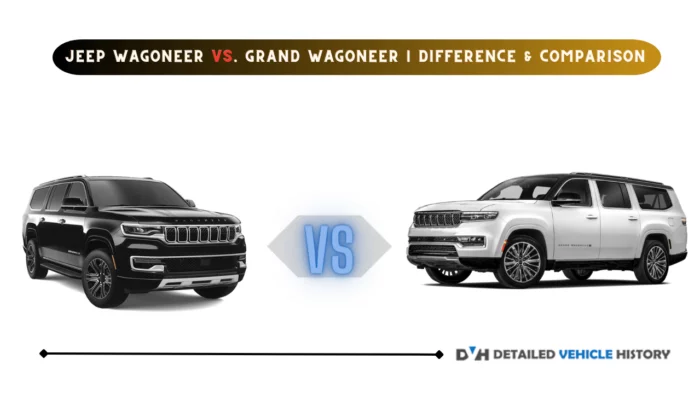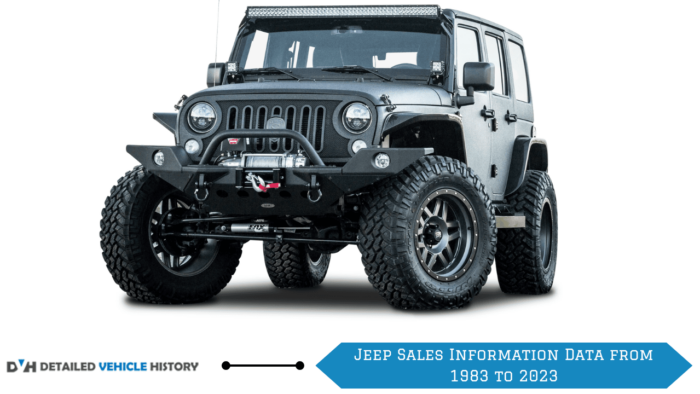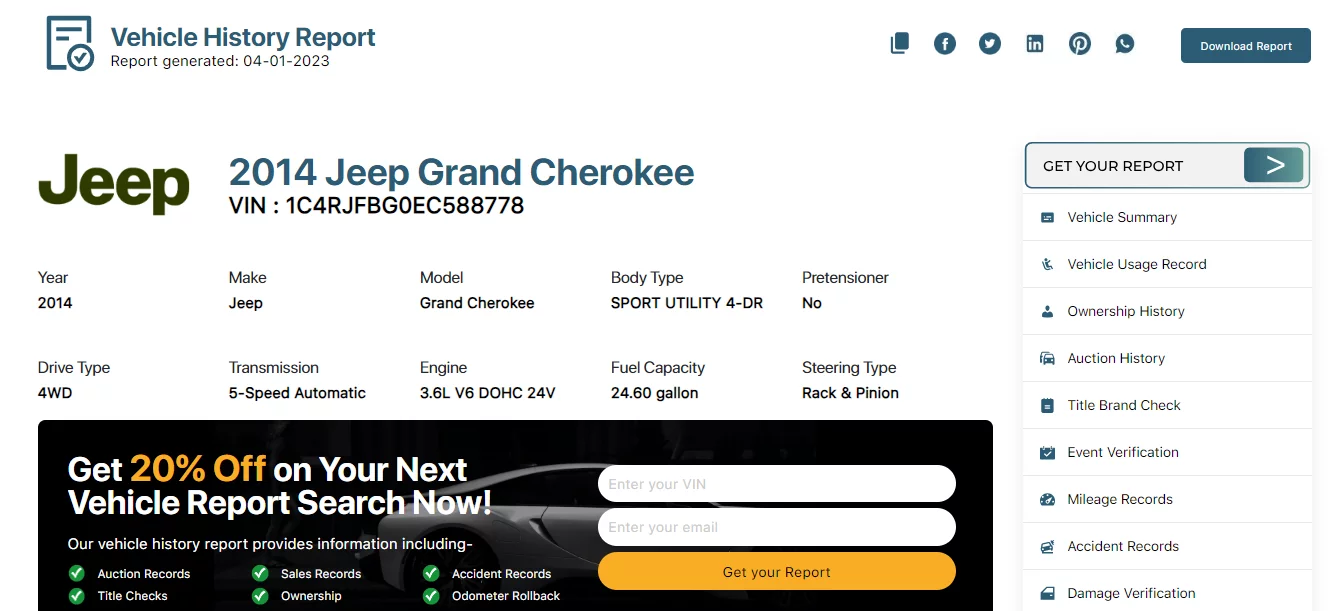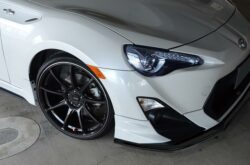The Jeep Wagoneer and Grand Wagoneer are iconic models in the Jeep lineup, known for their luxurious and spacious SUV designs.
These models mark Jeep’s foray into the premium SUV segment, offering a blend of Jeep’s off-road heritage with opulent features.
They are significant in the Jeep lineup, representing a leap into the upscale market and attracting a more discerning customer base.
Thank you for reading the Detailed Vehicle History blog, we’ll now consider the distinctive features, performance capabilities, and design elements of these models, highlighting both their differences and the common traits that make them exceptional additions to the SUV market.
The latest Grand Cherokee and Grand Wagoneer mark the return of three-row Jeep models, a category not seen since the introduction of the Commander back in 2006.
While the Grand Cherokee shares a unibody design lineage with Jeep’s current lineup, the Grand Wagoneer represents an entirely fresh and distinct design approach.
Jeep Wagoneer Vs Grand Wagoneer

1. Historical Overview
To fully appreciate the Jeep Wagoneer and Grand Wagoneer, it’s essential to journey back in time. These models have a rich heritage, with their roots tracing back to the original Wagoneer of the 1960s.
They embody Jeep’s commitment to versatility, durability, and adventure. Over the decades, these SUVs have evolved, adapting to changing tastes and technologies while staying true to their rugged essence.
The Jeep Wagoneer, an iconic SUV in Jeep’s lineup, has a storied history spanning several decades. It was first introduced in 1963 and continued to be offered until 1993, and then made a comeback in 2022.
Over the years, different iterations of the Wagoneer were produced in the United States and other countries.
It was initially manufactured by Kaiser Motors from 1962 to 1971, followed by American Motors from 1971 to 1987. Chrysler took the reins from 1987 to 1993, and Stellantis has been responsible for it since 2021.
A modern reincarnation of the Jeep Wagoneer was unveiled as a concept vehicle on September 3, 2020, and later introduced as a production model on March 11, 2021. The new Wagoneer hit the market in the latter half of 2021 as a 2022 model.
The year 1963 marked the debut of the inaugural Wagoneer models. These pioneering vehicles set a new standard by combining the comfort of passenger cars with a 4×4 drivetrain and an SUV body.
According to CNET, the initial Wagoneer offerings included two- and four-door models, each equipped with robust 140 hp Tornado 3.8-liter inline-six engines mated to Borg-Warner automatic transmissions.
2. Jeep Wagoneer vs Jeep Grand Wagoneer specs
When it comes to design and styling, the Jeep Wagoneer and Grand Wagoneer showcase a blend of classic ruggedness and modern elegance.
The exterior design of the Wagoneer embodies Jeep’s iconic seven-slot grille and bold lines, maintaining a timeless appeal.
The Grand Wagoneer takes things up a notch, offering a premium aesthetic with distinctive features like premium lighting elements and upscale trims.
Inside, the Grand Wagoneer is a testament to luxury, featuring high-quality materials and advanced technology.
The fourth-generation Wagoneer and Grand Wagoneer represent a pair of spacious SUVs, with the latter being a luxury edition, both built upon the foundation of the Ram 1500 (DT) chassis.
These vehicles debuted in March 2021, with the 2022 model year marking their entry as Jeep’s flagship models.
Manufacturing of the fourth-generation Jeep Wagoneers commenced in 2021, ushering in a new era of this iconic nameplate.
Here are detailed differences in specifications for the Jeep Wagoneer and Grand Wagoneer
Specifications Trim | Grand wagoneer Series-iii-Wagon | JEEP WAGONEER Series-ii-Obsidian-Wagon |
Drivetrain | Four Wheel Drive (Optional) | Rear Wheel Drive – Four Wheel Drive (Optional) |
Engine | 6.4L V8 (Optional) | 5.7L V8 w/eTorque (Optional) |
Number of Cylinders | 8 (Optional) | 8 (Optional) |
Fuel Type | Gasoline Fuel (Optional) | Gasoline/Mild Electric Hybrid (Optional) |
Fuel Capacity | 26.5 gal. (Optional) | 26.5 gal. (Optional) |
Torque | 455 ft. lbs. (Optional) | 404 ft. lbs. (Optional) |
Horsepower | 471 hp. (Optional) | 392 hp. (Optional) |
MPG (City/Hwy) | 13/18 (Optional) | 16/22 (Optional) |
Transmission | 8 Speed Automatic w/OD (Optional) | 8 Speed Automatic w/OD (Optional) |
Seating Capacity | 7 – 8 (Optional) | 7 – 8 (Optional) |
Cargo Capacity | 27.4 cu. ft. – 94.2 cu. ft. (Optional) | 27.4 cu. ft. – 116.7 cu. ft. (Optional) |
Towing Capacity | 9850 lbs. (Optional) | 10000 lbs. (Optional) |
Curb Weight | 6340 lbs. – 6342 lbs. (Optional) | 5960 lbs. – 6192 lbs. (Optional) |
Tires | P275/55TR20 – P285/45TR22 (Optional) | P275/55TR20 – P275/65TR18 – P285/45TR22 (Optional) |
Front Head Room | 41.3″ (Optional) | 41.3″ (Optional) |
Wheelbase | 123″ (Optional) | 123″ (Optional) |
3. Performance and Engine Options
Under the hood, both the Jeep Wagoneer and Grand Wagoneer offer an array of engine options to cater to different driving preferences.
From efficient V6 engines to powerful V8 powerhouses, there’s a choice for every driver. Performance metrics are impressive, with robust acceleration and towing capabilities.
Fuel efficiency varies depending on the chosen powertrain, but these vehicles are designed to balance power and efficiency.
When considering a Jeep or Grand Wagoneer, it’s important to note that each vehicle can come with different options and packages, allowing for customization at the time of purchase. To explore and understand the specific configuration of a particular vehicle, potential buyers can utilize the Jeep window sticker tool. This tool provides detailed information about the Jeep’s features, options, and packages, offering insights into the exact specifications of the vehicle. By using the window sticker tool, buyers can make more informed decisions, ensuring that the chosen Jeep or Grand Wagoneer aligns with their preferences and requirements.
The window sticker provides insight into the vehicle’s original options, packages, and features that it was equipped with upon leaving the dealership. Each owner tends to customize their vehicle to suit their preferences before it’s delivered. For instance, some may opt for cloth interiors, while others might choose a more luxurious leather finish. The value of a window sticker lies in comprehending the specific options the vehicle possesses, its original sale price, fuel efficiency details, and safety ratings.
On the other hand, vehicle specification information may be found using the VIN decoder application which is free to use.
4. Technology and Infotainment
Both the Jeep Wagoneer and Grand Wagoneer come equipped with cutting-edge technology. The infotainment systems are feature-rich, offering seamless connectivity, including smartphone integration and advanced navigation.
Driver-assistance features such as adaptive cruise control and lane-keeping assist enhance safety and convenience.
However Grand Wagoneer, in particular, takes technology to the next level with a premium audio system and advanced driver aids.
5. Interior Comfort and Space
Inside the cabin, the Wagoneer and Grand Wagoneer offer comfortable seating for seven or more passengers. The spacious interiors provide ample legroom and cargo space.
However, Grand Wagoneer stands out with its premium materials, including leather seats and elegant wood trims.
Both models prioritize passenger comfort and provide a luxurious driving experience.
6. Price and Trim Levels
When it comes to pricing and trim levels, the Jeep Wagoneer and Grand Wagoneer offer a range of choices to fit various budgets and preferences.
The Wagoneer provides a well-balanced value proposition, offering versatility and capability at a competitive price point.
The Grand Wagoneer, as the premium offering, comes with a higher starting price but delivers an abundance of luxury features and customization options.
Again these prices can be seen on the window sticker for Jeep this is known as the Manufacturer Suggested Retail Price while the trim information can be gotten from the VIN decoder. The table below shows the various trim levels for 2022 Wagoneer and Grand Wagoneer
Grand Wagoneer and Jeep Wagoneer Trims for 2022
| Grand Wagoneer | Jeep Wagoneer |
|
|
|
|
| |
|
7. Off-Roading Capabilities
While these SUVs excel in comfort and style, they don’t compromise on their Jeep DNA. Both models are well-equipped for off-roading adventures, with advanced four-wheel-drive systems, ground clearance, and off-road driving modes.
The Grand Wagoneer, in particular, brings a sense of luxury to off-roading, making it a top choice for those who seek adventure without sacrificing comfort.
8. Fuel Efficiency and Sustainability
In an era of increasing environmental awareness, the Jeep Wagoneer and Grand Wagoneer are designed with efficiency and sustainability in mind.
With modern engine technologies and eco-friendly features, they aim to balance power with responsible fuel consumption.
Sustainability initiatives may include improved aerodynamics and lightweight materials to reduce the carbon footprint.
5 Things to Do Before Buying a Used Jeep Vehicle

When buying a used Jeep, there are several crucial factors to consider to ensure you make an informed decision. It does not matter the particular Jeep you desire to buy, these points are applicable to all Jeep vehicles and other makes. Here are five key points to keep in mind:
Vehicle Inspection :
Thoroughly inspect the Jeep for any signs of wear, damage, or rust. Check the body, undercarriage, and frame for rust or corrosion, as Jeeps are often used for off-road activities. Look for signs of accidents or poor repairs, such as mismatched paint or uneven panel gaps. Pay attention to the condition of the tires, brakes, and suspension components.
Mechanical Condition:
Test drive the Jeep to assess its overall performance. Listen for unusual noises, vibrations, or irregularities in the engine, transmission, and suspension. Check for smooth operation of the four-wheel-drive system if applicable. If possible, have a trusted mechanic inspect the vehicle for any hidden mechanical issues. Jeeps often have specific mechanical components, such as the transfer case and differential, which should be checked for proper function.
Service and Maintenance Records:
Request the service and maintenance records from the seller. A well-documented history can provide valuable insights into how the Jeep has been cared for over the years. Look for regular oil changes, scheduled maintenance, and any repairs that have been conducted. This information can help you gauge the overall health of the vehicle and anticipate potential future issues.
Vehicle History Report:
Obtain a comprehensive vehicle history report through a reputable service such as Detailed Vehicle History or Instant VIN Report. This report can reveal important details about the Jeep’s past, including accidents, title information, odometer readings, and any reported damage. Look for any red flags that might indicate potential issues. The Jeep vehicle history report is a crucial step in ensuring transparency and making an informed decision about the purchase.
View Sample Jeep Vehicle History Report
Market Research and Pricing:
Research the market value of the specific Jeep model you are interested in. Consider factors such as the year, mileage, condition, and any additional features. This information will help you determine whether the asking price is fair and if there is room for negotiation. Be aware of common issues associated with the specific Jeep model and factor potential repair costs into your decision-making process.
Jeep Sales Information Data from 1983 to 2023

Conclusively, the comparison between the Jeep Wagoneer and Grand Wagoneer has revealed an intriguing blend of both differences and similarities. These models share a rich heritage while offering distinct characteristics to cater to various preferences and needs.
The Wagoneer retains its iconic Jeep DNA, providing a balance of performance, value, and off-road prowess. On the other hand, the Grand Wagoneer elevates the experience to a premium level, showcasing luxury in design, materials, and advanced technology.
For those seeking adventure, rugged durability, and a competitive price point, the Jeep Wagoneer stands as a solid choice. However, if luxury, top-tier features, and a taste of sophistication are your priorities, the Grand Wagoneer takes the spotlight.
Ultimately, choosing these two remarkable models depends on your lifestyle, aspirations, and the experience you’re looking for in your SUV. To truly appreciate their qualities, we invite you to explore the Jeep lineup further, which offers a range of vehicles designed to suit diverse preferences.
Whether you’re leaning towards the adventurous spirit of the Wagoneer or the refined luxury of the Grand Wagoneer, we encourage you to visit your nearest dealership and schedule a test drive to truly experience what these exceptional SUVs have to offer. Most times physical and mechanical inspection may not be sufficient, you will need to decode the Jeep VIN and confirm that specifications meet your needs, a vehicle history report can also expose the maintenance history, number of previous owners, accidents, theft records, and other details which a mechanical inspection may not readily provide.









